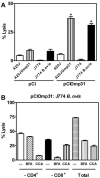A DNA vaccine coding for the Brucella outer membrane protein 31 confers protection against B. melitensis and B. ovis infection by eliciting a specific cytotoxic response
- PMID: 16177328
- PMCID: PMC1230944
- DOI: 10.1128/IAI.73.10.6537-6546.2005
A DNA vaccine coding for the Brucella outer membrane protein 31 confers protection against B. melitensis and B. ovis infection by eliciting a specific cytotoxic response
Abstract
The development of an effective subunit vaccine against brucellosis is a research area of intense interest. The outer membrane proteins (Omps) of Brucella spp. have been extensively characterized as potential immunogenic and protective antigens. This study was conducted to evaluate the immunogenicity and protective efficacy of the B. melitensis Omp31 gene cloned in the pCI plasmid (pCIOmp31). Immunization of BALB/c mice with pCIOmp31 conferred protection against B. ovis and B. melitensis infection. Mice vaccinated with pCIOmp31 developed a very weak humoral response, and in vitro stimulation of their splenocytes with recombinant Omp31 did not induced the secretion of gamma interferon. Splenocytes from Omp31-vaccinated animals induced a specific cytotoxic-T-lymphocyte activity, which leads to the in vitro lysis of Brucella-infected macrophages. pCIOmp31 immunization elicited mainly CD8(+) T cells, which mediate cytotoxicity via perforins, but also CD4(+) T cells, which mediate lysis via the Fas-FasL pathway. In vivo depletion of T-cell subsets showed that the pCIOmp31-induced protection against Brucella infection is mediated predominantly by CD8(+) T cells, although CD4(+)T cells also contribute. Our results demonstrate that the Omp31 DNA vaccine induces cytotoxic responses that have the potential to contribute to protection against Brucella infection. The protective response could be related to the induction of CD8(+) T cells that eliminate Brucella-infected cells via the perforin pathway.
Figures





Similar articles
-
Vaccination with the recombinant Brucella outer membrane protein 31 or a derived 27-amino-acid synthetic peptide elicits a CD4+ T helper 1 response that protects against Brucella melitensis infection.Infect Immun. 2005 Dec;73(12):8079-88. doi: 10.1128/IAI.73.12.8079-8088.2005. Infect Immun. 2005. PMID: 16299302 Free PMC article.
-
Improved immunogenicity of a vaccination regimen combining a DNA vaccine encoding Brucella melitensis outer membrane protein 31 (Omp31) and recombinant Omp31 boosting.Clin Vaccine Immunol. 2007 Jul;14(7):869-74. doi: 10.1128/CVI.00472-06. Epub 2007 Apr 11. Clin Vaccine Immunol. 2007. PMID: 17428946 Free PMC article.
-
A recombinant subunit vaccine based on the insertion of 27 amino acids from Omp31 to the N-terminus of BLS induced a similar degree of protection against B. ovis than Rev.1 vaccination.Vaccine. 2007 May 30;25(22):4437-46. doi: 10.1016/j.vaccine.2007.03.028. Epub 2007 Apr 2. Vaccine. 2007. PMID: 17442465
-
T cell immunity to brucellosis.Crit Rev Microbiol. 2003;29(4):313-31. doi: 10.1080/713608012. Crit Rev Microbiol. 2003. PMID: 14636042 Review.
-
Outer membrane proteins of Brucella.Ann Inst Pasteur Microbiol. 1987 Jan-Feb;138(1):87-9. doi: 10.1016/0769-2609(87)90081-0. Ann Inst Pasteur Microbiol. 1987. PMID: 3300721 Review. No abstract available.
Cited by
-
Immunization with Brucella VirB proteins reduces organ colonization in mice through a Th1-type immune response and elicits a similar immune response in dogs.Clin Vaccine Immunol. 2015 Mar;22(3):274-81. doi: 10.1128/CVI.00653-14. Epub 2014 Dec 24. Clin Vaccine Immunol. 2015. PMID: 25540276 Free PMC article.
-
Vaccination with the recombinant Brucella outer membrane protein 31 or a derived 27-amino-acid synthetic peptide elicits a CD4+ T helper 1 response that protects against Brucella melitensis infection.Infect Immun. 2005 Dec;73(12):8079-88. doi: 10.1128/IAI.73.12.8079-8088.2005. Infect Immun. 2005. PMID: 16299302 Free PMC article.
-
Partial protection against Brucella infection in mice by immunization with nonpathogenic alphaproteobacteria.Clin Vaccine Immunol. 2007 Oct;14(10):1296-301. doi: 10.1128/CVI.00459-06. Epub 2007 Aug 22. Clin Vaccine Immunol. 2007. PMID: 17715332 Free PMC article.
-
Meta-Analysis and Advancement of Brucellosis Vaccinology.PLoS One. 2016 Nov 15;11(11):e0166582. doi: 10.1371/journal.pone.0166582. eCollection 2016. PLoS One. 2016. PMID: 27846274 Free PMC article.
-
Protection of mice against Brucella abortus 544 challenge by vaccination with recombinant OMP28 adjuvanted with CpG oligonucleotides.Vet Res Commun. 2010 Feb;34(2):119-32. doi: 10.1007/s11259-009-9337-x. Epub 2009 Dec 16. Vet Res Commun. 2010. PMID: 20013309
References
-
- Al-Mariri, A., A. Tibor, P. Mertens, X. De Bolle, P. Michel, J. Godefroid, K. Walravens, and J. J. Letesson. 2001. Protection of BALB/c mice against Brucella abortus 544 challenge by vaccination with bacterioferritin or P39 recombinant proteins with CpG oligodeoxynucleotides as adjuvant. Infect. Immun. 69:4816-4822. - PMC - PubMed
-
- Alton, G. 1985. Rev. 1 and H38 Brucella melitensis vaccines, p. 215-227. In P. M. Verger (ed.), Brucella melitensis. Martinus Nijho, Dordrecht, The Netherlands.
-
- Anonymous. 1986. Joint FAO/W.H.O. expert committee on brucellosis. World Health Org. Tech. Rep. Ser. 740:1-132. - PubMed
Publication types
MeSH terms
Substances
LinkOut - more resources
Full Text Sources
Other Literature Sources
Research Materials
Miscellaneous

